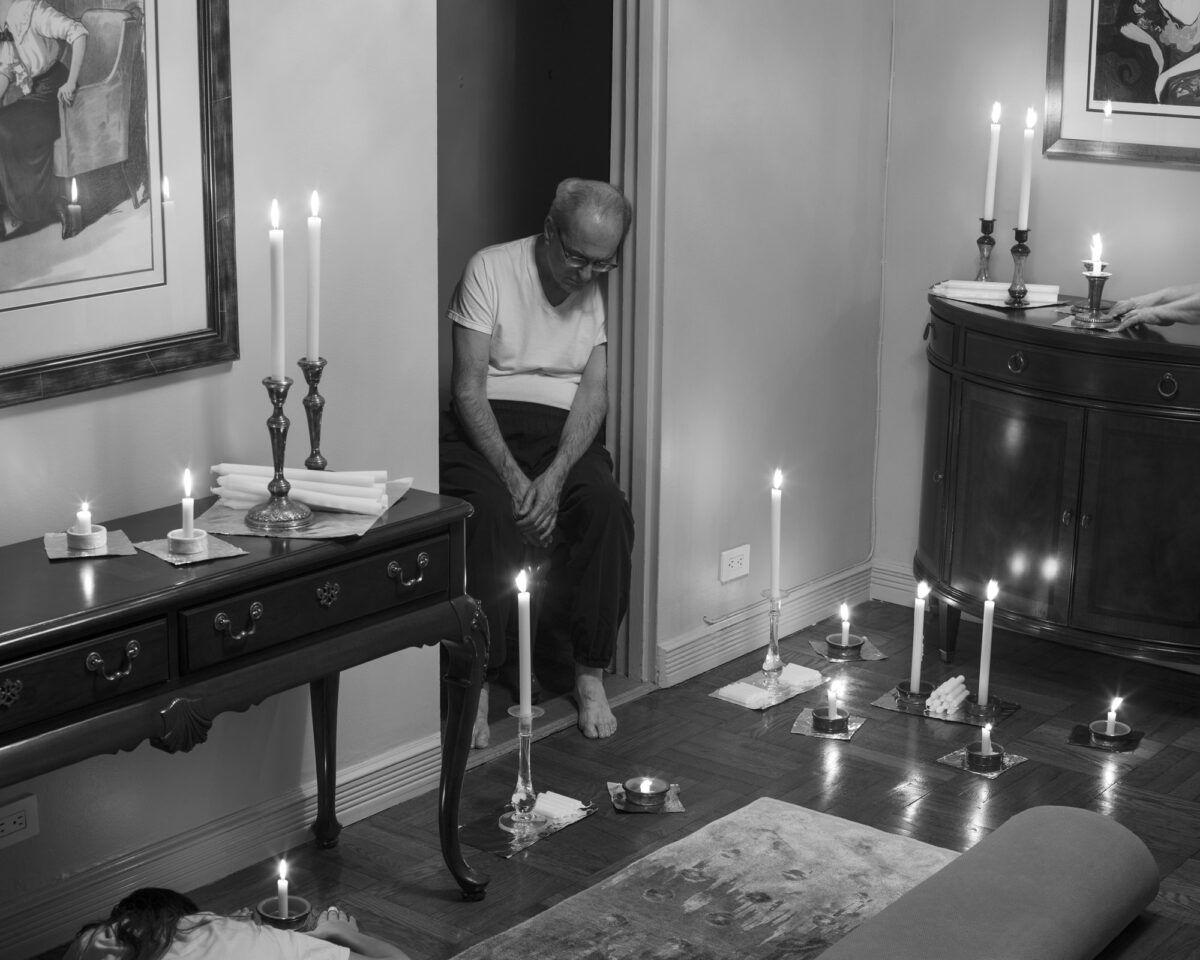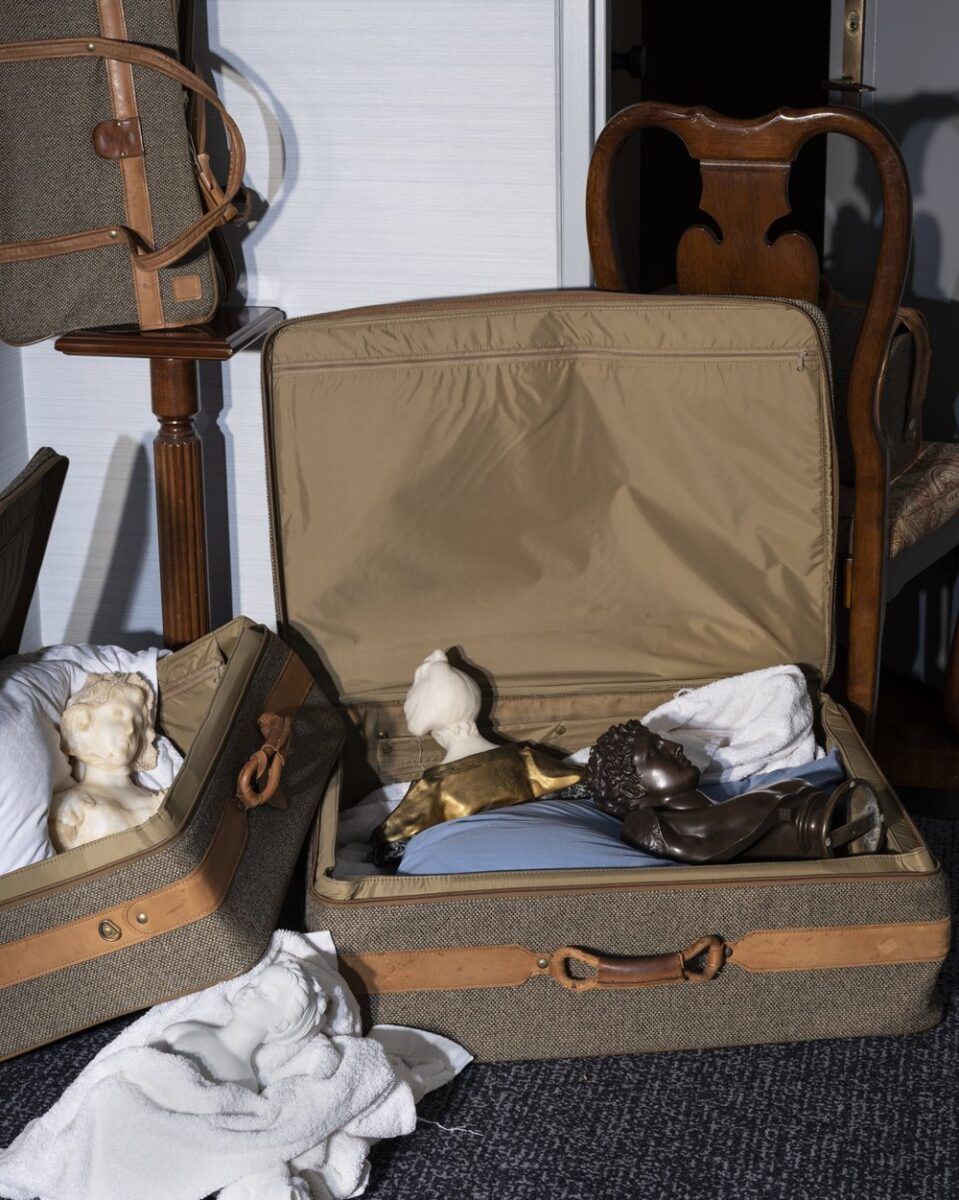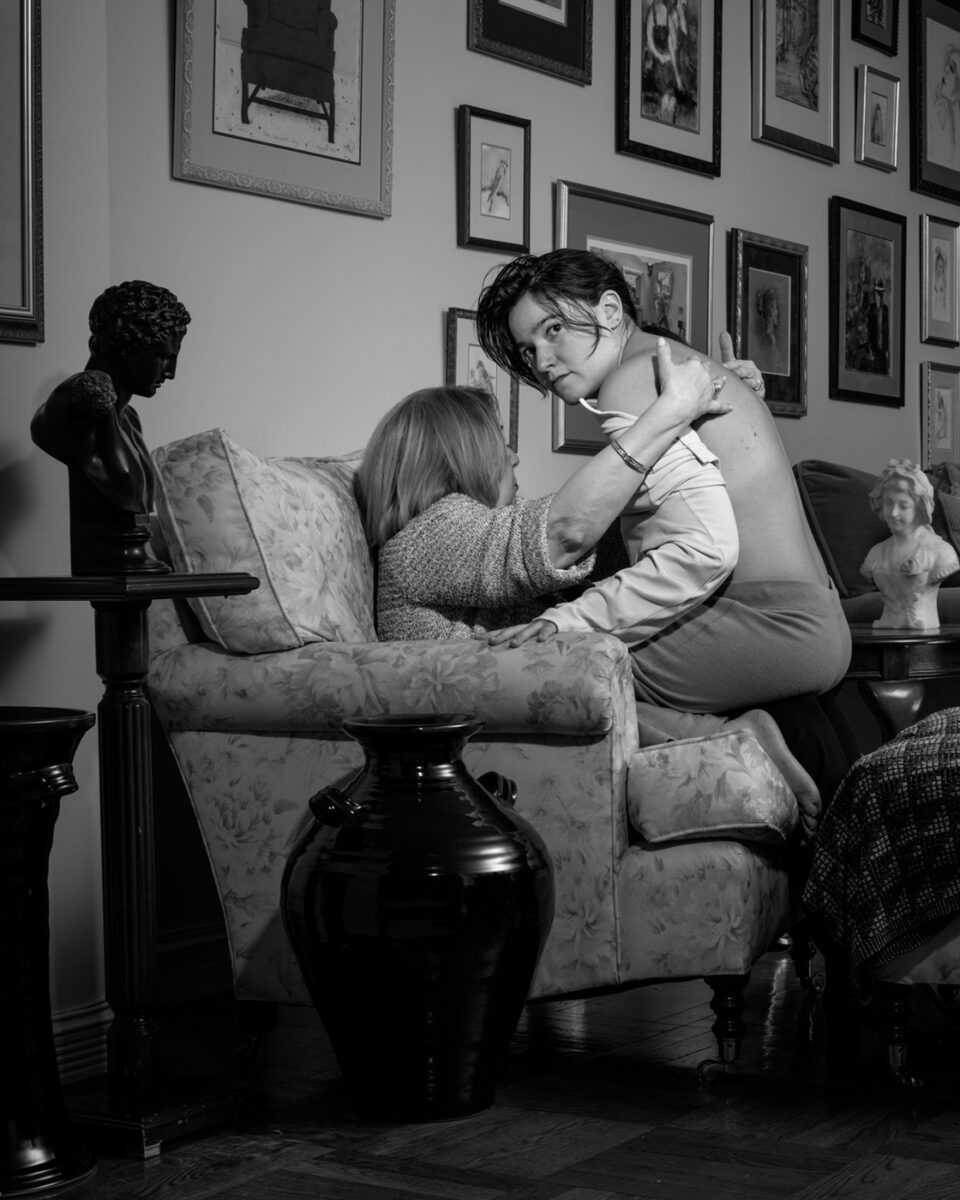blog
Interview with featured photographer Alana Perino

‘Ritual’ from ‘In a Condition of No Light’ © Alana Perino
Alana Perino’s photographic work delves into the complex, layered narrative of their family’s history within the confines of a dimly lit apartment, a space imbued with both beauty and fragility. Perino is the featured photographer for Issue #130: Inhabit. For this issue and exhibition, artists were asked to present work which is about the place in which they live. Present work that captures their connection to their space, and how the space they inhabit shapes their life.
Perino’s staged scenarios and quasi-candid moments explore the intersection of personal memory, inherited trauma, and societal constructs. Utilizing the family abode as a stage, Perino constructs “fictions rooted in autobiography,” where family members become actors in a play who grapple with themes of domesticity, identity, and the lingering presence of their Jewish ancestry. The resulting images, a blend of posed portraits, still lifes, and evocative interiors, serve as a visual excavation of familial dynamics, aiming to disrupt established patterns and cultivate a space for healing and empathy.
::
Cary Benbow (CB): Let’s talk about how your project represents your connection to the space you inhabit. Can you expand on your statement and tell us a little more?
Alana Perino (AP): All the images from In a Condition of No Light are made in a single apartment. The apartment is quite small, approximately a thousand square feet. The people who live in and have lived in the apartment are incredibly particular about their lives and about their things, and their relationships. I myself am an incredibly particular person, and once lived there. Because of this, the apartment becomes a palpable stage for the spoken and unspoken dramas that transpire between those who inhabit the space. I’m also interested in how we inhabit our bodies and how ancestry can appear somatically or ritualistically within those bodies. Our bodies become homes: our homes become bodies. I engage with the particularities of these bodies and the space, and the objects within, which also become bodies and homes, not simply as a case study in patterns of domesticity but also as a means to generate new relationships with the home, with the self, with family, and some who we may have never known who may be closer to the self than we realize. The home is a stage, a museum, a mausoleum, and a mirror.
CB: How does the work relate to your other projects? Is it similar or how is it significantly different?
AP: In all my work I am interested in the relationship between home, belonging and heritage. In the past I have examined these themes in the American landscape by considering the opaque and disorienting nature of historic sites across the continental US. I have also made lyrical images of my father and his home on a barrier reef island off the west coast of Florida, as he contended with his wife’s passing amongst the natural and spiritual ecosystems of the wetlands, mangroves, and beaches. In a Condition of No Light remains seated in some of these same nuanced questions about place, memory, and connection, but it diverges in how it calls attention to the nature of its own making. The work is highly staged. Sometimes I will spend all day creating one image. This is not something I necessarily try to hide, as the artifice heightens the nature of the drama.
CB: What inspires your art? What kind of stories do you wish to tell?
AP: When my mother and I lived alone we watched film noirs and went to the theater. I was and remain fascinated by outmoded melodrama, the way light can become a character, how people merge into mise en scène, and how objects take on motive. Because the work is made in my mother’s apartment, and because my mother’s side of the family is Ashkenazi Jewish, I intensify the significance of the melodramatic heritage of that culture, a heritage that was suppressed by the assimilation of that diaspora into whiteness. The culture of American theater is very much rooted in Yiddish theater. There is a neurosis present in that drama, a condition inherited, something pathologized and often invisibilzied that I wish to make seen.
CB: What is your earliest memory of taking photos?
AP: More significant than my earliest memories taking photos are my memories of photos being made of me. My mother loved to photograph me when I was young. I would dress up and pose for her daily. We would progress through dozens of outfit changes, and I instinctively knew how she wanted me to look like in the images, feminine, coy, sophisticated, sweet. We have a similar practice now, but the roles have reversed. She poses for me in a variety of outfits, wearing a variety of archetypical masks. Now I am the photographer, but also the actor, the set designer, and the lighting technician. Above all I am the director. I have always been the director.
CB: Of the times you’ve shared or shown your work so far, what has made the biggest impact on your career, or left a lasting impression?
AP: The curatorial process for each show has an impact on my practice. It is sometimes a rare opportunity to show work in a public forum. Because of this I always try to take a new risk, either with sequencing or by including newly developed images or experimenting with installation techniques. Sometimes those risks fail, and the gesture doesn’t resonate. Sometimes they are generative. Every opportunity is a chance for an iteration, and this is what keeps my practice moving forward.
CB: There are so many forms of creative expression, what makes photography your choice?
AP: I am interested in death and how things live on after death. I think of all the mediums, pun intended, photography is death’s closest companion.
CB: In your opinion, what makes a good photograph?
AP: One that I remember.
CB: What or who are your important inspirations? If a certain photographer has qualities that you admire, how does that inform your own creative process?
AP: Lately I have been looking to Joanna Piotrowska’s photographic and installation practice. I drove to Philadelphia to see her show Unseeing Eyes and Restless Bodies at ICA. Her work is in deep conversation with the bodies photographed, the spaces they occupy, and the sites where the work is eventually installed. It is my desire for In a Condition of No Light to be this profoundly site specific.
CB: How do you describe your photography to someone who’s not familiar with it?
AP: I find it difficult to classify my work broadly. If I must, I call it autobiographical fiction. There is some narrative in my work, but I prefer to resist narrative. There is some documentary in my work, but I prefer to avoid that as well. If ever my work becomes too rooted in certainty, logic, or rigidity, I know that it’s time to destabilize something.
CB: What advice would you give to someone who wants to take on projects like yours?
AP: No one knows your work and your practice as well as you do. There are many well-intentioned people, with great words of advice but eventually you will have to learn to trust yourself, your process, and what you make. You cannot create work for everyone. It may be possible that you will only make work for one person. Find one person that isn’t you to make work for, this effort alone will eventually be enough to resonate with a universe.
::

‘Washington’s Tent’ from ‘Go to the Land and I Will Show You’ © Alana Perino

‘Suitcases’ from ‘In a Condition of No Light’ © Alana Perino

‘Mother’s Lap’ from ‘In a Condition of No Light’ © Alana Perino
::
Alana Perino is a photographer and Assistant Professor at Johnson & Wales University in Providence, Rhode Island. Perino’s personal work has been exhibited and awarded internationally and throughout the United States, as well as being in the collections of the Brown Library, and the Rhode Island School of Design Library.
https://www.alanaperino.com/
Location: Online Type: Featured Photographer, Interview
Events by Location
Post Categories
Tags
- Abstract
- Alternative process
- Architecture
- Artist Talk
- artistic residency
- Biennial
- Black and White
- Book Fair
- Car culture
- Charity
- Childhood
- Children
- Cities
- Collaboration
- Community
- Cyanotype
- Documentary
- Environment
- Event
- Exhibition
- Faith
- Family
- Fashion
- Festival
- Film Review
- Food
- Friendship
- FStop20th
- Gender
- Gun Culture
- Habitat
- Hom
- home
- journal
- Landscapes
- Lecture
- Love
- Masculinity
- Mental Health
- Migration
- Museums
- Music
- Nature
- Night
- nuclear
- p
- photographic residency
- Photomontage
- Plants
- Podcast
- Portraits
- Prairies
- Religion
- River
- Still Life
- Street Photography
- Tourism
- UFO
- Water
- Zine

Leave a Reply